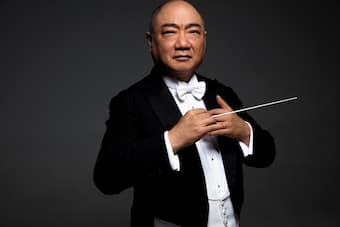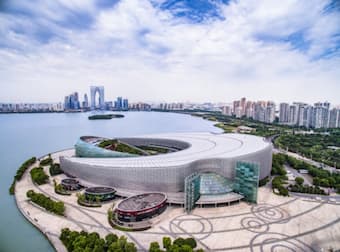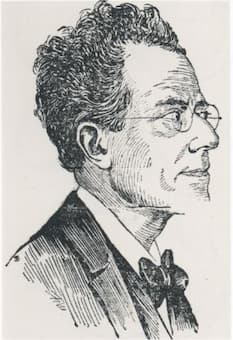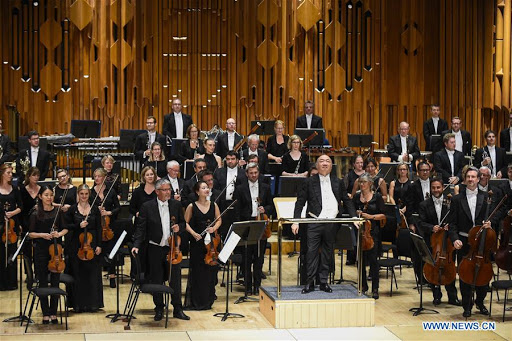
Xu Zhong © Shu Xiaoning
The number of symphony orchestras in China has grown exponentially over the last couple of years. One of the newest kids on the block is the Suzhou Symphony Orchestra founded in 2016. This enormous orchestral flowering has in large part been stimulated and maintained by China’s most acclaimed and accomplished conductors, among them the internationally renowned Xu Zhong. Born into a well-respected family dynasty of physicians in the city of Shanghai, Xu displayed exceptional music talent at an early age. Endowed with prodigious talent and a generous scholarship he received his formal piano training in the class of Dominique Merlet at the Conservatoire National Supérieur de Musique de Paris.
Xu Zhong quickly won numerous prestigious international piano competitions, and following in the footsteps of Barenboim, Ashkenazy, and Pletnev, Xu Zhong has ventured into the world of conducting with resounding success. He has collaborated with many prestigious orchestras in Asia and in Europe, and his talents are particularly in vogue at the leading opera houses in Europe. Xu Zhong was awarded the Chevalier de L’Ordre des Arts et des Lettres by the French Ministry of Culture and Communication in 2010, and he was appointed an Officier de l’Ordre des Arts et des Lettres in 2018.
Richard Strauss: Ein Heldenleben Op.40
(Maestro Xu Zhong & Suzhou Symphony Orchestra)
The beautiful city of Suzhou is located in southeastern Jiangsu Province, roughly 100 kilometers northwest of Shanghai. A major economic center and focal point of trade and commerce, the city has a history dating back 2,500 years. Its stone bridges, pagodas and gardens are part of the UNESCO World Heritage Sites, and Suzhou is frequently called the “Venice of the East.” Given this rich historically heritage, the city is well known for its cultural musical treasures including traditional Chinese and Kunqu Opera. However, the establishment of a symphony orchestra had to wait until 2016.

Suzhou Culture and Arts Center © Wendy Wei Tours
Founded to address a growing demand for classical music, the Suzhou Symphony Orchestra was formed and Chen Xieyang was named as the first music director. The orchestra received a dedicated Concert Hall, located within the Suzhou Culture and Arts Center. Designed by Yasuhisa Toyota, the Suzhou Jinji Lake Concert Hall offers accommodations for 500 audience members, and it is built by incorporating the latest advances in acoustics. The Suzhou Symphony Orchestra has quickly gained a dedicated following and a well-deserved professional reputation. In today’s extraordinary concert, this rising orchestra is under the direction of Maestro Xu Zhong in a performance of Gustav Mahler’s Wayfarer Songs and his 5th Symphony. We are delighted that Maestro Xu Zhong has agreed to share his thoughts on this particular event.
What do you think is behind this excitement for the establishment of new orchestras, and the explosive growth of classical music in China?
My generation is very lucky, it has not only witnessed the vigorous development of symphonic music in the 20th century in China, but also personally participated in and experienced this process. I think the healthy development of a particular industry is dependent on several factors. The first is education. The education regarding symphonic music or Western classical music in China is divided into two types; one is for the general public and the other is for the professional. I received a very good professional music education when I was a student, so most of the audience knows me as Xu Zhong the pianist.
Instrumentalists, conductors, and composers educated in a professional music education system surely need a performing platform. However, classical music, an elegant form of art from the West, actually took a relatively long time to accept musicians from the East. This is not just about the musicians. It involves a second point, which is closely related to the foreign cultural exchanges of our country, and the continuous improvement of our country’s international status. I have lived in France for sixteen years. As a Chinese who lived in another country, I can deeply feel the “inner-power” that my country is able to bring to the practitioners in the music and art industry.

Suzhou Symphony Orchestra © szsorch.com
The third is the vigorous development of theatres, concert halls and opera houses in China. In the past, watching a play or listening to a concert was in fact an extravagant activity. Presently, the consumption of cultural products is gradually rising, and the demand for new theatres, concert halls and opera houses is steadily increasing. This is actually very good news, as it reflects the continuous improvement in the artistic education of the common people.
The fourth is the establishment of countless music ensembles in recent years. For example, the Suzhou Symphony Orchestra is the 74th professional orchestra in China. Since then, dozens of new orchestras have been established and they are performing publically. The reason why they can be the conveyors of high art is the direct result of a highly demanding market. There will be supply and demand only if there are audiences. So this brings us to the starting point: we need more and better musicians and educators.
Those aspects I mentioned above are interlinked and indispensable, they form a complete industrial ecological chain. In addition to being a conductor and the president of the Shanghai Opera House, I am also the Dean of the Soochow University School of Music. Therefore, I have a deep understanding of the important role that education plays in the cultivation of a person, and especially its influence on art and music education.
Can you tell us something about your personal and professional experiences with the Suzhou Symphony Orchestra?
The city of Suzhou has a profound cultural background. It only took two weeks for the high management to issue the approval for the establishment of the Suzhou Symphony Orchestra. I have been the chief conductor of the Suzhou Symphony Orchestra since its establishment. It is not an easy thing to build a new orchestra. In order to enable it to have a high starting level, and to make sure it possesses the highest professionalism, we recruited musicians from all over the world. Besides Beijing and Shanghai, we also organised auditions in cooperation with local institutes and orchestras in the United States, Israel, South Korea, France, and Italy. In terms of orchestra management and operation, we set our benchmark to the highest international standards, so this orchestra has an exceptional level of internationalisation, specialisation, and professionalism in China. We completed the establishment of this orchestra in only eight months; such a short period of time is considered unimaginable in other parts of the world.
As a professional orchestra we needed to establish a dedicated and in-house music season. Over the past four years, I have worked with the administrative team to set the development direction for the orchestra by focusing on the essence of music, and the cultivation of diverse audiences. We have diversified our concerts and performances to cover such genres as symphonic music, opera, crossover, and chamber music.
Every orchestra is actually a cultural bridge. Suzhou is an exquisite and elegant city, and many world-class musicians have been invited to perform. For this ancient city dating back more than 2,500 years, I believe an orchestra is more than just a series of concerts. In the early days of the establishment of the Suzhou Symphony Orchestra, the Bat Shir Choir from Israel was invited to present the concert version of the opera “Die Fledermaus.” The orchestra has also invited Alberto Negroni (Principal Clarinet of the Teatro alla Scala and Filarmonica della Scala), Pierre Fourchenneret, Eric Picard (Principal Cello of the Orchestre de Paris), Alessandro Lanzoni Trio, Hehui, Daniel Oren, Jean-François Heisser, Wang Jian, John Axelrod, Philippe Aïche, tenor Han Peng, baritone Sun Li, and pianist Song Siheng, among numerous others. The music and voices of these world-class ensembles and soloists have brilliantly resonated in this beautiful city.

Gustav Mahler, 1911 © Mahler Foundation
What are the challenges of successfully communicating Mahler to contemporary audiences?
Unlike the compositions of musicians working during the classical age, Mahler composed many profound works in a late romantic style; they are not easy to decode and understand. What Mahler comprehended and conveyed in music was his outlook on the world and on his life. As such, his music is destined to be expansive in length, rich in structure, complicated in orchestration, and plentiful in colour.
As conductors, we can analyse Mahler’s work by reading, studying and understanding the musical scores. But for audiences, it is relatively difficult. Therefore, it is not enough to simply communicate a faithful and profound rendition of the score. For me personally, I find it necessary to present Mahler’s works to the audience in the manner of an oil painting, essentially in a cinematic manner.
MAHLER: SONGS OF A WAYFARER
Inspired by an unhappy love affair with a singer during his time in Kassel, Mahler penned a number of poems and set four of them to music for voice and piano. The Songs of a Wayfarer is Mahler’s first mature composition, and the sentiment is almost certainly autobiographical. Mahler sees himself as the protagonist, “a traveling journeyman who has met with adversity, setting out into the world and wandering on in solitude.” The poems are heavily influenced by the folk verses from the “Wunderhorn Collection,” and Mahler orchestrated the accompaniment in 1890. For the youthful composer, the Wunderhorn aesthetic expressed his position in the world, and it subsequently transferred into the symphonic context as well. Musically, Mahler is treating the voice and instruments symphonically, and they speak to us with a great and powerful emotional force. Mahler intuitively hoped that his music would transport us “to a world beyond our ordinary perception.”
The juxtaposition of Mahler’s 5th and the Songs of a Wayfarer on the same program is an interesting choice; what was the thinking behind that?
As an epoch-making composer, Mahler was driven by a strong spirit of innovation. “Lieder eines fahrenden Gesellen” is Mahler’s first vocal suite. He poured the pain caused by his failed love affair into the music, and he also inherited the sentiments from Schubert’s “Die Winterreise.” Initially, it was a song accompanied by the piano and Mahler only later prepared the symphonic cloak. As such, he pushed the dramatic properties of the art song to unknown extremes.
The 5th Symphony has a special place in Mahler’s work. It is often considered to mark the beginning of his “mid-term work.” If you listen to Mahler’s Symphony No.5, No.6, and No.7, you will find that the orchestration is very different from his previous symphonies, in which he focuses much more on the independence of the instruments and uses polyphony to delineate different sections. Treating the orchestra like a chamber ensemble, Mahler creates a highly contrapuntal texture by using only a few instruments. When he wrote his 5th Symphony, Mahler suffered from severe internal bleeding, but at the same time he studied Beethoven‘s late string quartets. Deeply moved, the layout of the five movements of this symphony follows the Beethovenian model in terms of structure, motivation, and goals. I think Beethoven’s spirit should have also played an important role in strengthening Mahler at that time.
The 5th Symphony and “Lieder eines fahrenden Gesellen” are full of innovation and emotional strength. That’s why we decided to title this concert “SONG OF LIFE.” I want to communicate to the audience that the most important driving force in Mahler’s life was love. As such, love is the eternal theme of “SONG OF LIFE.”
Gustav Mahler: Songs of Wayfarer, “When my sweetheart is married” (Janet Baker, mezzo-soprano; Hallé Orchestra; John Barbirolli, cond.)
How do you approach the delicate musical and emotional counterpoint between today’s soloist and the orchestra?
I think the first and most important thing is balance. The roles of soloists and orchestras are different, and the effects and functions are also different. It calls for a measured and complimentary approach, without the orchestra pushing the soloist into a desperate situation.
The second is the sense of direction, which has nothing to do with the rhythm and dynamics. It means to make sure that the soloist and the orchestra are moving towards a common goal and in the same direction. Since the projected lines are very clear, this sense of direction must be approached with great caution.
Gustav Mahler: Songs of Wayfarer, “I walked across the field this morning” (Thomas Quasthoff, bass-baritone; Cologne Radio Orchestra; Gary Bertini, cond.)
In terms of interpretation, what can you as a conductor add to our understanding of Mahler’s setting of poetry?
Mahler experienced racial antagonism, social chaos, marriage breakdown, depression and other issues, which deeply influence his works. Those themes are often grand and profound, juxtaposing life and death, love and hate, sacred and secular, classical and ethnic, individual and universal. Mahler revealed his unique personality in music; he penetrated history and he mirrored the turbulent world around him as well. As a conductor, I am just a messenger of Mahler, and I wish to communicate the different moods in Mahler’s music to today’s audience.
Gustav Mahler: Songs of Wayfarer, “The two blue eyes of my beloved” (Thomas Hampson, baritone; Vienna Philharmonic Orchestra; Leonard Bernstein, cond.)
MAHLER: SYMPHONY NO. 5
On 24 February 1901, Gustav Mahler (1860-1911) unexpectedly collapsed in his apartment. His sister Justine discovered him lying in a pool of his own blood, and only an emergency operation for an intestinal haemorrhage saved his life. He subsequently reported to his close friend Natalie Bauer-Lechner: “When I saw the faces of the two doctors, I thought my last hour had come…. While I was hovering on the border between life and death, I wondered whether it would not be better to have done with it at once, since everyone must come to that in the end. Besides, the prospect of dying did not frighten me in the least… and to return to life seemed almost a nuisance.”
This statement of resigned acceptance seems rather curious for a man in his early forties, yet we must remember that thoughts of death had preoccupied the composer since childhood. The second of fourteen children of whom only six survived into adulthood meant that he was part of “a funeral every other week.” To the outside world it seemed that Mahler quickly forgot about this life-threatening episode. There can be no doubt, however, that it profoundly changed not only the man, but also the composer. In Mahler’s 5th Symphony the focus on strict form and textural transparency led Bruno Walter to remark, “Mahler was aiming to write music as a musician.” And Arnold Schoenberg suggested that Mahler’s 5th Symphony “rightfully belongs to the “new” music of the twentieth century.”
As a musician and conductor, how do you approach this emotionally highly explosive work?
The 5th Symphony is the most Viennese-styled symphony of Mahler. He quotes vague fragments of his arts songs in different movements. When composing this work, Mahler used a variety of new polyphonic techniques, structures, textures, themes and orchestration to reflect his attitude towards death and his desire for light. Thus the interpretation is very difficult, and as a conductor I need to be very deliberate and specific in handling this work in terms of strength, speed, emotion, and colour.
Gustav Mahler: Symphony No. 5 “Funeral March” (Harold Farberman, cond.; London Symphony Orchestra)
Mahler was deeply spiritual and highly emotional, yet also a meticulous craftsman. How does this juxtaposition influence your interpretations?

© www.news.cn
Mahler uses an extremely large orchestra, yet he is a master in the arrangement and placements of tones. His orchestration is extremely clear and delicate, which allows him to precisely articulate a variety of philosophical themes in his music. As the chief conductor of the Vienna opera he had access to countless operatic masterpieces, and he therefore composed very tense and dramatic music. Mahler vocalised his symphonies and symphonised vocal conventions. In other words, he employs vocal procedures as part of the orchestral sound to create the timbres he wanted. In rehearsal, I usually ask the musicians to accurately play every mark in the scores, so that the changes and depth in the music can be understood more clearly.
For conductors, interpretation is a way of second creation. The best way for me to pay tribute to Mahler is through vigorous analysis and by infusing my interpretations with great passion.
How important is the central “Scherzo,” which simultaneously contains moments of great anxiety and jubilation?
This movement is like a big development with muddy and dark currents mixed into a joyful Viennese waltz. Mahler deliberately marked “obligato” in the horn (meaning obligatory), so this movement is more like a horn concerto. In terms of expression marks, Mahler asked for “strong and not too fast,” which requires the musician to pay meticulous attention. Moreover, this is a movement that combines multiple elements of scherzo, sonata and trio. It is full of layers and demonstrates Mahler’s superb composing techniques. The movement demands the highest concentration from the conductor and the orchestra to convey these elements to the audience.
Gustav Mahler: Symphony No. 5 “Scherzo” (New York Philharmonic Orchestra; Bruno Walter, cond.)
The most famous and most hotly debated movement in the 5th Symphony is the “Adagietto,” which really doesn’t seem to fit the rest of the work. In terms of meaning, emotional content and musical pace, what is your approach?
This movement is scored for strings and harp to express Mahler’s feelings for his wife. It actually sounds four times in the famous movie “Death in Venice,” just like the finishing touches to a painting.
As the long introduction to the final movement, it is often played as a single piece during a concert, and it is considered to be a very important piece. Some people think the interpretation should be brighter and cheerful, because it is Mahler’s non-verbal love song to his wife, and it is a foreshadowing of the final movement. But I prefer to slow down the speed by half to stimulate the “singing” of the music. After the music is stretched, with clear and smooth melodies and less regular beat and a slower rhythm, it much more clearly discloses Mahler’s intention—gloom and sadness.
For more of the best in classical music, sign up to our E-Newsletter
Gustav Mahler: Symphony No. 5 “Adagietto” (James Chambers, horn; New York Philharmonic Orchestra; Leonard Bernstein, cond.)



